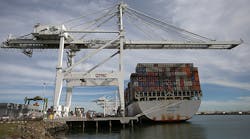UPDATE: FEBRUARY 14, 2015:
Labor Secretary Tom Perez has announced that he will directly intervene in the ongoing port labor contract dispute between the International Longshore and Warehouse Union (ILWU) and Pacific Maritime Association (PMA). That prompted this reaction from Jonathan Gold, vice president of supply chain with the National Retail Federation: "We welcome the administration's attention to this important national and international economic and supply chain issue and hope it recommits the two sides to reaching a deal. The slowdowns, congestion and suspensions at the West Coast ports need to end now."
Import cargo volume at the nation’s major retail container ports is expected to rise 10.1% this month over the same time last year even as West Coast ports come closer to a possible shutdown due to the lack of a contract with dockworkers, according to a report from the National Retail Federation and consulting firm Hackett Associates.
“With cargo volume growing as the economy continues to recover, the last thing we need is a port shutdown that would bring billions of dollars of economic activity to a halt,” says Jonathan Gold, NRF’s vice president for supply chain and customs policy. “Whether it’s in retail, manufacturing, agriculture, or other industries, there are too many jobs that rely on the ports to let that happen. Labor and management need to do whatever it takes to reach an agreement and do it today.”
Following negotiations that began last spring, the contract between the Pacific Maritime Association and the International Longshore and Warehouse Union expired on July 1, 2014. Despite nine months of ongoing talks, the lack of a contract and other operational issues has led to crisis-level congestion at the ports, and retailers and other businesses asked President Obama in late December to engage with both parties and encourage the use of a federal mediator. A mediator arrived in San Francisco on January 6 and talks have continued but an agreement has yet to be reached.
Ports covered in the study handled 1.44 million twenty-foot equivalent units (TEUs) in December, the latest month for which after-the-fact numbers are available. That was up 3.2% from November and 9.3% from December 2013. That brought 2014 to a total of 17.3 million TEUs, an increase of 6.6% over 2013’s 16.2 million. One TEU is one 20-foot-long cargo container or its equivalent.
January was estimated at 1.48 million TEUs, up 7.5% from January 2014. February is forecast at 1.37 million TEUs, up 10.1% from last year; March at 1.34 million TEUs, up 3%; April at 1.49 million TEUs, up 4.3%; May at 1.56 million TEUs, up 4.9%, and June also at 1.56%, up 5.3%. Those numbers would bring the first half of 2015 to 8.8 million TEUs, an increase of 5.8% over the same period last year.
“East Coast ports have been the beneficiaries of the labor disputes on the West Coast,” observes Ben Hackett, founder of Hackett Associates, referring to the shift of market share that has occurred as cargo has been diverted in recent months because of West Coast congestion. “We have to admit that we underestimated the level of the switch.”



